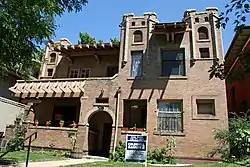Walter Rice, also known as Walter L. Rice (1866–1930), was an American architect, inventor, and engineer. He made a career as an architect in Denver, Colorado, particularly for the design of apartment buildings. Several of his buildings are designated National Register of Historic Places. He patented inventions for automobiles.
Early and personal life
Rice was born in Monticello, Iowa in April 1866.[1][2] He was one of seven children born to Manley and Jane Rice and was raised in Monticello.[3] His wife, Florence, was born in November 1869 in Iowa. They were married about 1887 and had a daughter, Edith, in November 1889 in Colorado.[1] After a three-year-illness,[2] Rice died in 1930.[4] He is buried at Fairmount Cemetery in Denver.
Career
Rice began his career in Chicago, Illinois as Chief Engineer for Corn Products Company. He contributed to the process of extracting corn syrup by steam pressure.[5] He moved to Denver in 1889 and between 1890 and 1901 he is listed as a carpenter, draftsman, and then architect.[2] He worked as an architect in Denver, planning the mechanical, electrical and structural engineering for the buildings.[5] He was the partner of Charles Quayle in the firm of Quayle & Rice beginning in 1905.[4]

In 1899, he designed an eclectic-style home at 1800 Gilpin Street.[6] Walter Rice traveled to Mexico and Guatemala in the 19th century, where he developed an interest in Mexican colonial buildings. In 1901, he design and built Cornwall Apartments in the Capitol Hill section of Denver, which may have been the first Mexican Colonial building in Denver. It was listed on the National Register of Historic Places in 1976.[5] It is considered one of the best of Walter Rice's buildings according to Thomas Jacob Noel and Barbara S. Norgren.[7] Other architects later found that the style was better suited to the climate than the prevailing Victorian and European architectural styles.[5]

In 1909, he designed the Eppich Apartments, an example of American Craftsman style architecture. It was listed on the National Register of Historic Places in 1984.[2]
By 1913, he had been a building inspector for the city and county of Denver. He was interested in forming laws for building construction.[8] In 1925, he designed two apartment buildings on East Tenth Street, Granada Apartments and Cardenas Apartments. Both are three-story buildings based upon Spanish Colonial and Moorish architectural styles. There are arched bays made of white plaster that contrast with red brick walls, curvilinear parapets, and iron balconies.[9] He worked as a member of the Allied Architects Association from 1923 to 1928. The association was formed to design the City and County Building of Denver. Rice was the architect of the Old Ladies Home at 38th Avenue and Quitman Street.[2]

In 1914 he file a patent for a pneumatic spring for vehicles (patent 1,160,321).[10] He also worked on improvements to carburetor of early automobiles to increase mileage.[5] In 1920, he filed a patent for the Charge-forming device for internal-combustion engines (patent 1,406,416).[11]
References
- 1 2 "Walter Rice, 2065 Welton Street, Denver", United States of America, Bureau of the Census. Twelfth Census of the United States, Washington, D.C.: National Archives and Records Administration, 1900
- 1 2 3 4 5 Julian S. Midgorden; James L. Salvador (January 5, 1984). "National Register of Historic Places Inventory/Nomination: Eppich Apartments". National Park Service. Retrieved June 29, 2018. With accompanying photos
- ↑ "Walter Rice, born about 1866, Monticello, Iowa", Tenth Census of the United States. Records of the Bureau of the Census, Record Group 29, Washington, D.C.: National Archives, 1880
- 1 2 Thomas Jacob Noel; Barbara S. Norgren (1987). Denver, the city beautiful and its architects, 1893-1941. Historic Denver, Inc. p. 215, 216. ISBN 978-0-914248-04-0.
- 1 2 3 4 5 Helen M. Arnit (October 8, 1976). "National Register of Historic Places Inventory/Nomination: Cornwall Apartments". National Park Service. Retrieved June 29, 2018. With accompanying photos
- ↑ Amy B. Zimmer (2013). Denver's Historic Homes. Arcadia Publishing. p. 113. ISBN 978-1-4671-3058-5.
- ↑ Thomas Jacob Noel; Barbara S. Norgren (1987). Denver, the city beautiful and its architects, 1893-1941. Historic Denver, Inc. p. 86. ISBN 978-0-914248-04-0.
- ↑ Journal of the American Institute of Architects. American Institute of Architects. 1913. p. 305.
- ↑ Thomas J. Noel (May 1, 2016). Denver Landmarks and Historic Districts. University Press of Colorado. p. PT183. ISBN 978-1-60732-422-5.
- ↑ United States. Patent Office (1915). Official Gazette of the United States Patent Office. U.S. Patent Office. p. 757.
- ↑ Official Gazette of the United States Patent Office. The Office. 1922. p. 284.